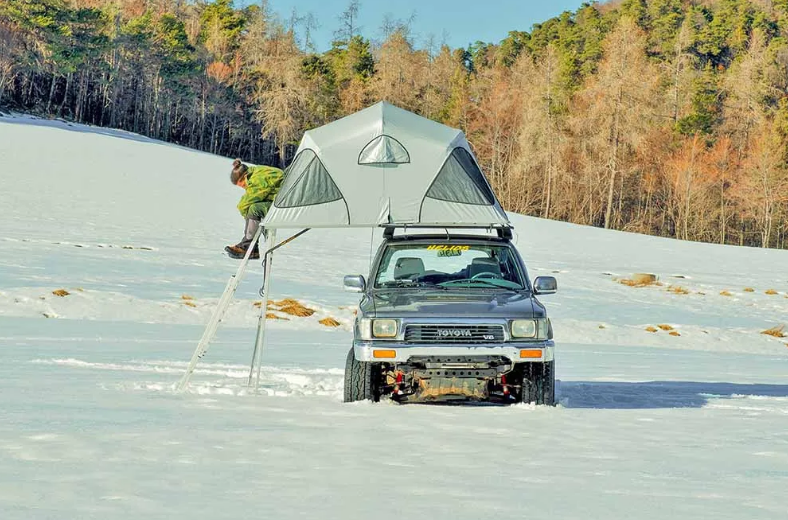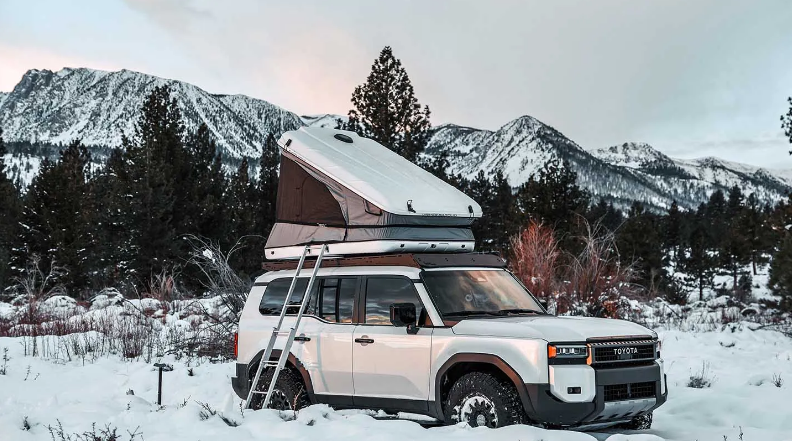Winter transforms familiar landscapes into serene, snow-covered wonderlands. For those willing to brave the cold, it also offers solitude, stunning views, and a fresh kind of adventure. Rooftop tents make winter camping surprisingly manageable—but there are some key things to know before heading out.
In this guide, we skip the generic “wear layers” advice and dive straight into cold-season strategies specifically tailored for rooftop tent campers. Whether you’re escaping to a quiet national park or tackling an alpine road trip, these practical tips will help you stay warm, dry, and ready for anything.
Can You Use a Rooftop Tent in Winter?
Absolutely. Rooftop tents can be ideal for winter use, offering several advantages over ground tents:
Quick Setup and Breakdown – Crucial when you’re exposed to wind and freezing temperatures.
Snow? No Problem – Elevated tents don’t require you to shovel or compact snow for setup.
No Frozen Stakes – Skip the struggle of driving tent stakes into icy ground.
Less Moisture from Below – Since you’re off the ground, you avoid losing heat to cold soil and snow.
Better Sleep Setup – Rooftop tents often come with full-floor mattresses, keeping campers warmer and more comfortable.
However, not all rooftop tents are created equal. Winter camping demands certain features to ensure comfort and safety:
What to Look for:
Hard Shell Design: Faster to deploy and better in wind and snow.
Windproof & Waterproof Fabric: Keeps out gusts and slush while reducing flapping noise.
Sturdy Construction: Especially important for tents with flat roofs that can accumulate snow.
Ventilation System: Essential for minimizing condensation.
Insulated Mattress: Look for dense foam that resists heat loss.
Stowable Ladder: Helps prevent icing when not in use.

Hard Shell vs. Softshell Tents
While softshell tents can work in cold weather, hard shell rooftop tents are generally preferred for winter use. Their aerodynamic shape sheds snow better, and their gas strut-assisted setup is faster, which matters when you’re racing daylight or dealing with wind chill.
High-end options like the James Baroud Space or Vision series offer a combination of speed, wind resistance, and comfort that’s hard to beat in freezing conditions.
Rooftop Tent Takedown in Snow
If you’re using a hard shell tent, packing up in snow is straightforward. But with softshell models, you’ll need to be extra careful. These tents fold over themselves to close—if snow is left on the roof, it can get pressed into the interior, making your sleeping space damp.
To avoid soggy bedding:
Brush off all snow before closing
Use a microfiber towel to wipe away remaining moisture
Keep a snow brush handy, especially for latches and hinges
Practice setup and takedown while wearing gloves so you’re not fumbling in freezing temps
Staying Warm in a Rooftop Tent During Winter
Even though rooftop tents offer better insulation than most ground tents, you’ll still need to take steps to retain body heat. Here’s what works:
1. Electric Blankets
Plug them into a portable power station to warm up your sleeping bag before bedtime. They’re not meant for all-night use but offer great comfort in the first few minutes when you’re crawling in.
2. Insulation Kits
Custom-fitted thermal liners or insulation kits attach to the tent walls and help trap heat inside. Unlike DIY blankets, these don’t sag or get in the way of entry and exit.
3. Diesel Heaters
Diesel heaters are the gold standard for tent warmth. They sit outside the tent and pump dry heat in through a small duct. Unlike propane heaters, they don’t add moisture and work well with well-insulated tents. Just remember: always power them with a secondary battery—never your car’s starter battery.
⚠️ Pro Tip: Your sleeping bag is your first line of defense against the cold. Never rely solely on powered gear for warmth—redundancy is key.

Consider an Annex Room for Harsh Weather
One of the downsides of rooftop tents in winter? No vestibule space. That’s where an annex room comes in handy.
These attach to your tent’s ladder entry point and create a weatherproof buffer zone, perfect for:
Removing wet boots
Stashing gear
Cooking safely outside the sleeping area
Shielding your ladder from ice buildup
Some annexes, like those by James Baroud, offer full enclosures with zippers and connection tunnels—ideal for staying organized in snow and wind.
Preventing Condensation in Cold Conditions
Condensation is a common issue in cold-weather camping. Even in dry air, a single person can release up to 1 liter of moisture overnight via breath and sweat. That moisture turns into condensation when it hits cold tent walls.
Strategies to Prevent Condensation:
Crack a window open—yes, even in winter—to allow humid air to escape
Use ventilation fans (like the built-in ones in James Baroud tents)
Open the tent during the day to air it out between uses
Add anti-condensation mats under your mattress to prevent moisture buildup
Remember: condensation isn’t just an annoyance—it can lead to soaked gear and hypothermia if not managed properly.
Final Thoughts
Rooftop tents are a fantastic way to camp in winter—offering speed, comfort, and safety that ground tents can’t match. But winter camping does require planning. Invest in the right gear, learn how to manage moisture and heat, and practice setting up your tent in cold conditions before you hit the trail.
Whether you’re heading to a snow-covered forest or a windy mountain ridge, the right rooftop tent setup can turn a challenging night into a cozy adventure.
